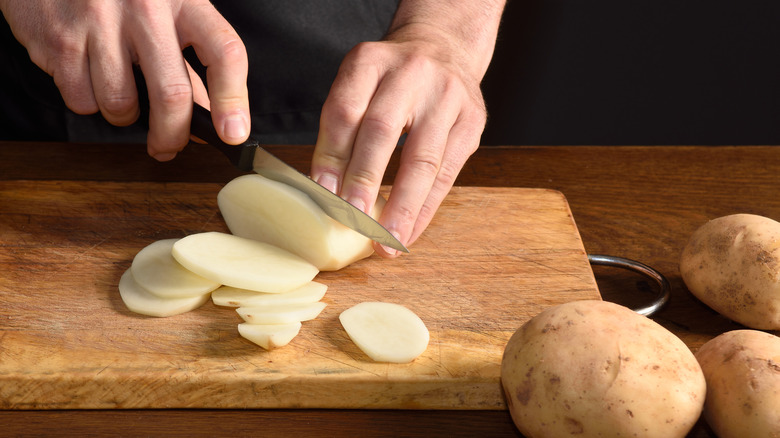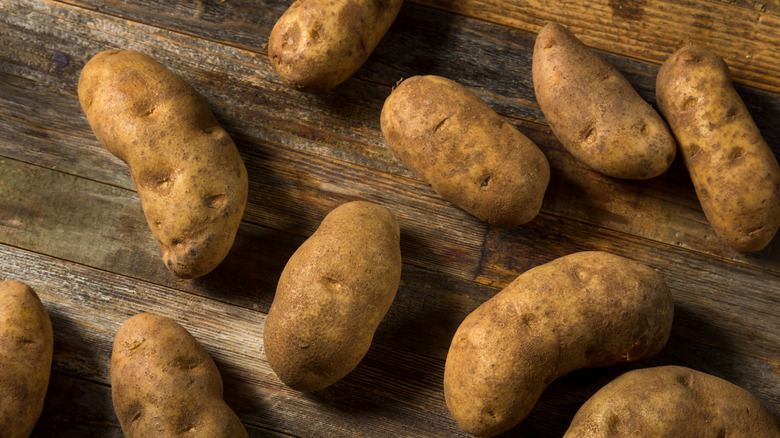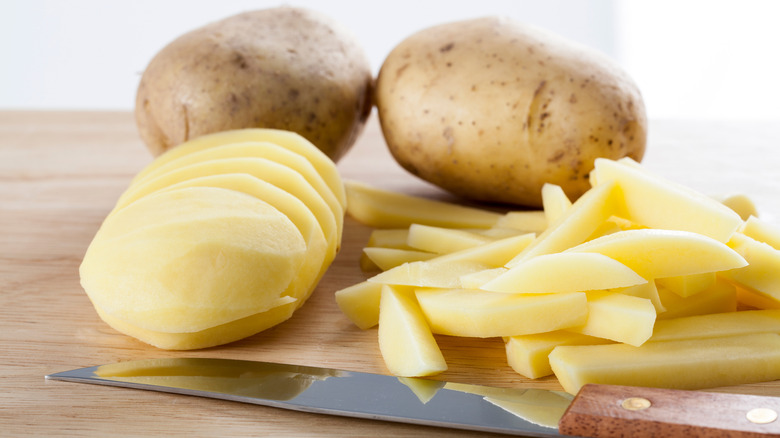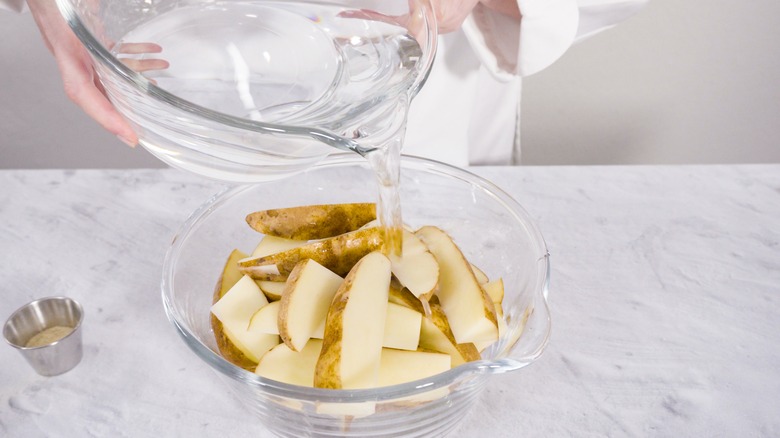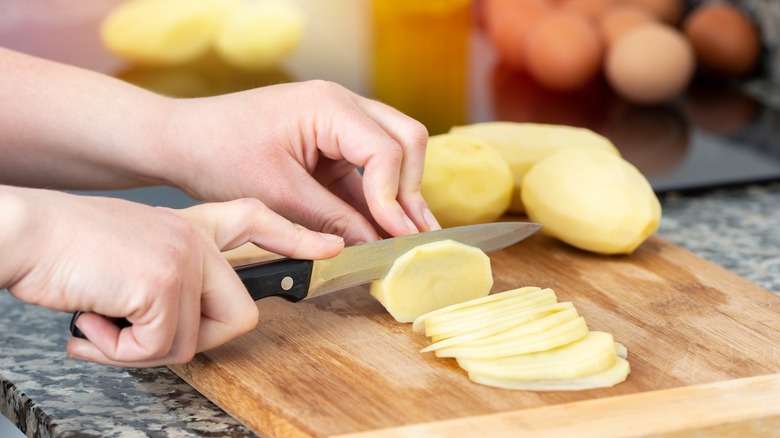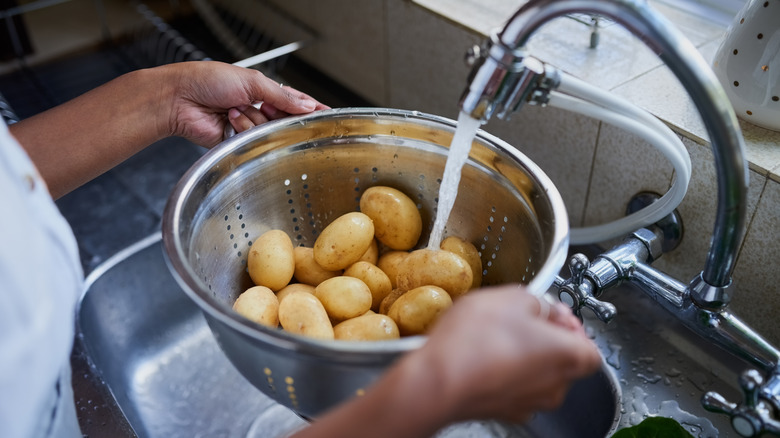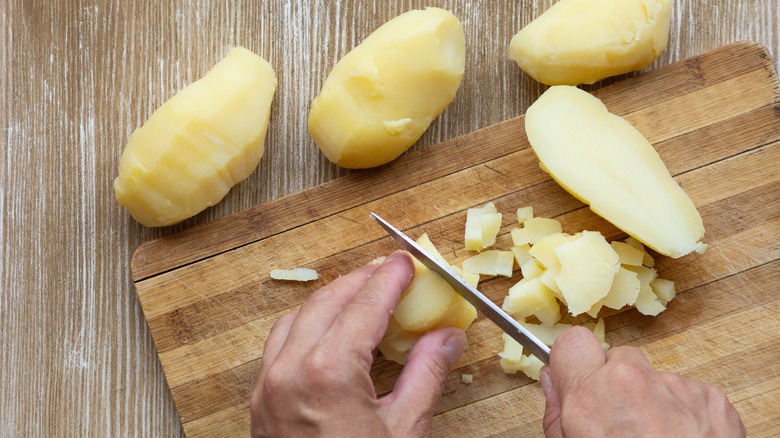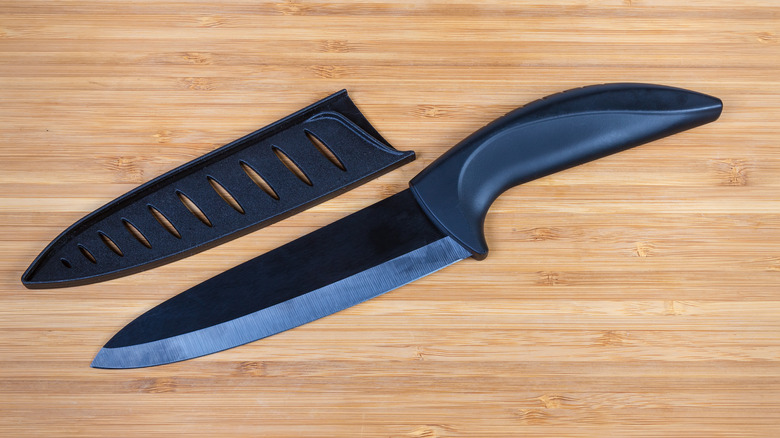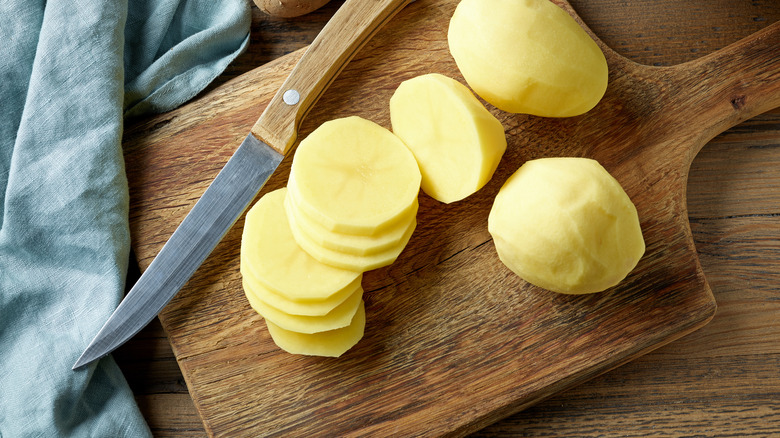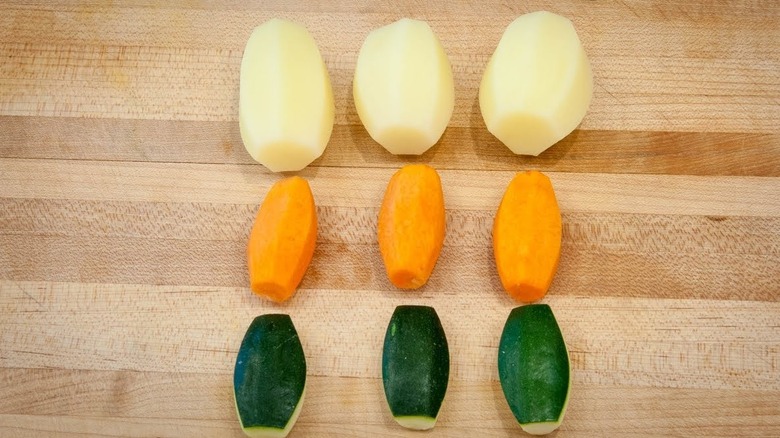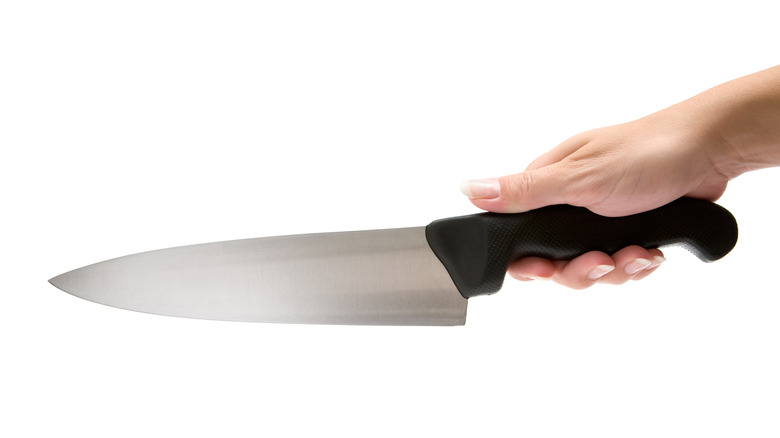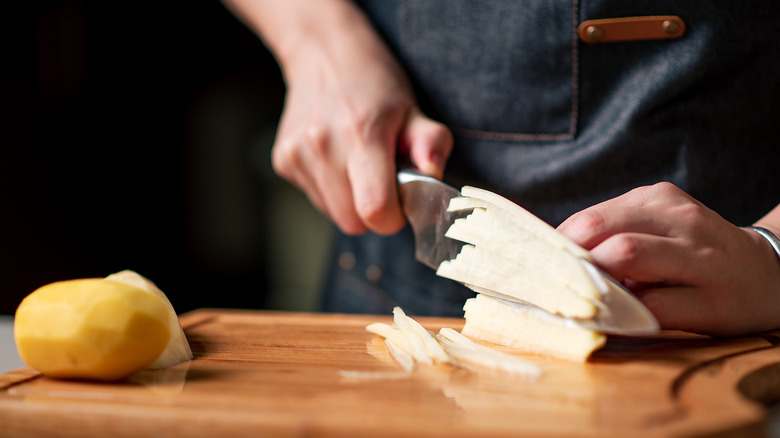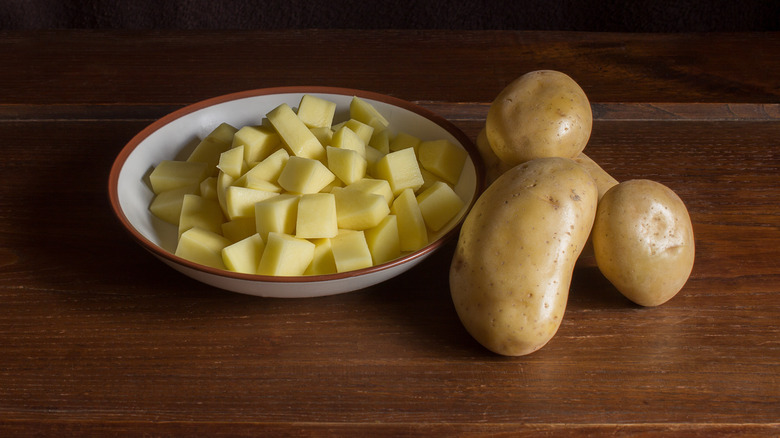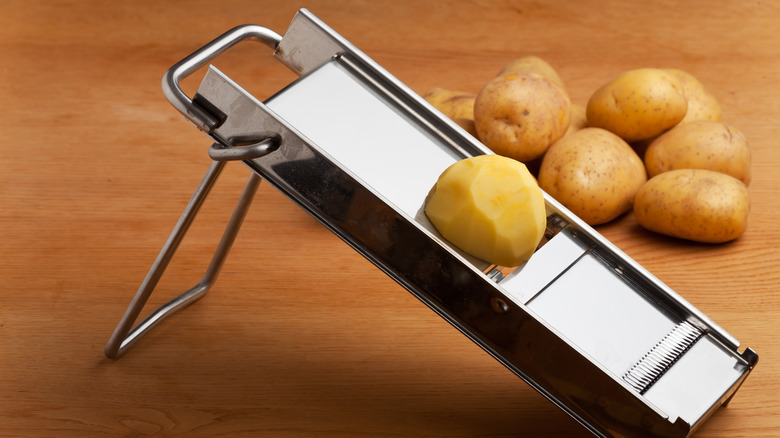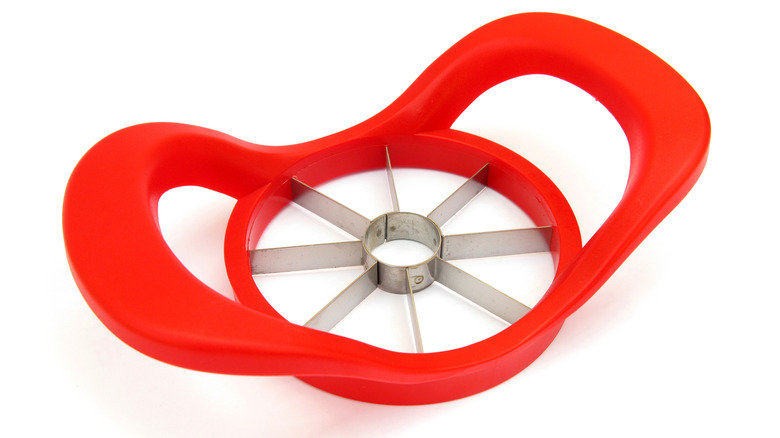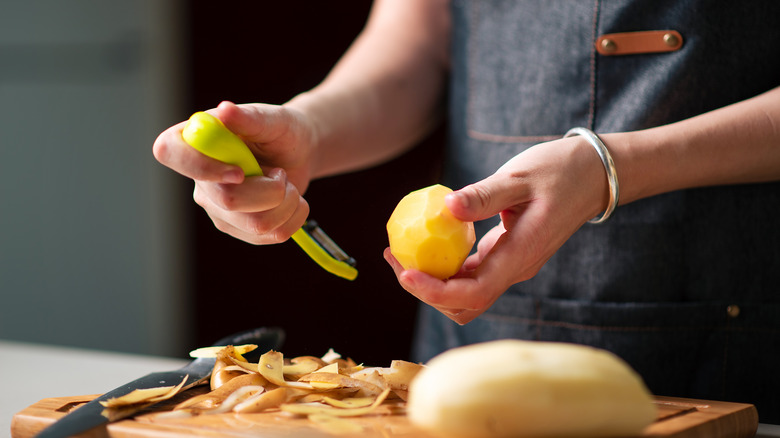15 Tips You Need To Make Cutting Potatoes Much Easier
Potatoes are a culinary staple in virtually every cuisine around the world, loved for their versatility, nutritional value, and affordable price. You can roast them, bake them, mash them, fry them, or boil them, and each method results in a unique flavor profile and texture that's undeniably delectable. But, before any of this can happen, there's one step that's universal to nearly all potato dishes — cutting them. Cutting potatoes may seem like a menial, mundane task, yet it holds great significance, being a crucial cog in the wheel that influences the outcome of your dish. Your method of cutting determines the cooking time, the texture, and even the flavor of the potatoes. Imagine biting into a potato salad where some pieces are perfectly cooked while others are hard or overly mushy. The root cause of such culinary missteps often lies in the inconsistent cutting of the potatoes. A uniform cut ensures even cooking and provides a consistent taste and texture to your dish, enhancing the overall eating experience.
Choose the right potato variety
Selecting the proper potato variety is key to easier cutting and peeling. There are three main types of potatoes: starchy, waxy, and all-purpose. Starchy potatoes, such as russets, possess a high starch content, resulting in a light, fluffy texture when cooked. Given their textural properties, they are often the preferred choice for baking, frying, and mashing. In contrast, waxy potatoes, including red potatoes, exhibit a creamier, denser texture when cooked. Their lower starch content and higher moisture allow them to hold their shape well, making them ideal for cutting once cooked. Their firmness after cooking makes them a perfect choice for potato salads where maintaining shape post-cutting is desirable.
Yukon Golds, classified as all-purpose potatoes, strikes a balance between starchy and waxy potatoes. Their texture and starch content allows them to perform well in various cooking methods. When cooked, they remain firm, ensuring they hold up well under the knife. It's essential to note that the freshness of potatoes can also influence how well they can be cut after cooking. Regardless of the type, older potatoes may become excessively soft or mushy when cooked, making them difficult to cut neatly. Thus, always opt for potatoes that feel firm and heavy for their size with smooth, unblemished skins for the best cutting experience post-cooking.
Use a sharp knife
A sharp knife is the single most important tool for easier potato cutting. Imagine trying to slice through a potato with a dull blade. The pressure needed to penetrate the potato's skin is significantly more than with a sharp knife. Not only does this make the process more laborious and time-consuming, but it also increases the risk of the knife slipping off the potato and causing an injury. A sharp knife, on the other hand, provides smooth, effortless cuts and offers better control, reducing the chance of accidents.
Over time, knives will dull with use and will need sharpening. But how does one determine when sharpening is needed? One of the easiest ways to test if your knives are sharp is by trying out a "paper test." This involves vertically holding a sheet of standard matte printer paper and attempting to slice through it with the knife, starting from the heel of the blade and moving horizontally to the tip. If the knife fails to glide smoothly through the paper, it indicates that it is dull and requires sharpening.
Soak the potatoes before cutting to prevent discoloration
Once cut, sliced or diced potatoes will oxidize, which causes them to brown or turn gray when exposed to air. This phenomenon occurs when the phenols and enzymes in the potato's cell walls are exposed to oxygen, causing a chemical reaction that turns cut potatoes pink. Using a dull potato peeler or knife can exacerbate this effect by damaging more of the potato's cell walls. Although this discoloration is harmless, it can be prevented by submerging cut potatoes in cold water, creating a barrier against oxygen and maintaining their color. If potatoes have already turned pink, their color can be restored using ascorbic acid or vitamin C powder, vinegar, or lemon juice. This adjusts the pH level, returning the potatoes to their original color.
However, if the color doesn't concern you, the potatoes can be cooked as usual without any additional steps. Soaking potatoes in water before cutting doesn't just maintain their fresh, appetizing appearance, but it also makes the cutting process smoother. When potatoes are submerged in water, the exposure to oxygen is limited, slowing down the enzymatic reaction that causes discoloration.
Use a cutting board as a solid base for cutting
A sturdy cutting board provides a non-slip surface to make cutting potatoes easier and safer. Without a board, potatoes can roll around and lead to uneven, inaccurate cuts. They are also more prone to slipping, which may cause injury. For cutting potatoes, choose a large wooden or plastic cutting board. Wooden boards are naturally anti-microbial and provide some give to make cutting more comfortable. Plastic boards are very durable and maintenance-free but harder under the knife. Choose a board that's big enough to give you plenty of room to work. A large cutting board allows you to safely move your knife and handle your potatoes without worrying about them falling off the edge.
After cutting, immediately transfer the potato pieces to water or broth to prevent browning or cook them right away. A cutting board provides an ideal workstation when preparing potatoes, but cut pieces deteriorate quickly when exposed to air. To prolong the life of your cutting board, use one side for cutting vegetables (like potatoes) and the other side for handling raw meats. This can also help to prevent cross-contamination.
Rinse the potatoes to remove excess starch
It is critical to thoroughly wash vegetables, including potatoes, before consuming them to eliminate potential contaminants like E.coli, Salmonella, and Listeria, which are responsible for numerous food-related illnesses. Besides safety, washing potatoes is essential for food quality, especially when preparing fried potato snacks like fries, chips, or hash browns. It is essential to rinse potatoes before frying or baking because potatoes contain a high amount of starch in the form of tiny granules. When potatoes are cut, starch is released, making the pieces feel sticky and causing them to clump together. Rinsing cut potatoes in cold water helps wash away excess starch and prevents sticking. This makes the potato pieces easier to handle and improves their texture when cooked on roast potatoes or french fries. Rinsing the potatoes after an initial cut can make the subsequent cuts smoother as it washes off the released starch, which may cause some resistance.
Cut the potatoes from an angle for a smoother cut
The angle at which you cut potatoes impacts how smoothly and evenly they slice or dice. A straight cut down through the vegetable can be difficult to achieve uniformly with each slice. Cutting potatoes at an angle on a bias provides more control and consistency. Holding the potato at an approximately 45-degree angle to your cutting surface changes the cutting plane, so you are slicing through less of the potato with each cut. This makes it easier to apply even pressure and achieve the same thickness with each slice. The angled cutting technique works especially well for oblong or oval potatoes that otherwise tilt and shift under the knife. Angled cuts may take some practice to perfect, but the results are well worth it. Wedges, slices, and cubes with clean, sharp edges that retain their shape during cooking. The cuts also have visual appeal for garnishing or appetizers.
Consider using a knife guard for additional safety
When cutting potatoes or any produce, kitchen safety is paramount. A knife guard is an inexpensive yet practical accessory that helps shield fingers from injury while slicing and dicing. For frequent or high-volume potato cutting, a knife guard provides peace of mind and an added layer of protection. A knife guard is a device, typically made of metal or sturdy plastic, covering part of the blade. It allows the knife to cut food while restricting how much of the blade is exposed during cutting. This limits the depth of potential cuts and nicks to fingers and hands.
The two most common types of knife guards are finger guards and cut-resistant gloves. Finger guards protect fingers closest to the cutting edge of the knife, and they typically cover about 1 to 1.5 inches of the blade from the tip. Finger guards are minimal, inexpensive, and best for light or occasional cutting. However, more of the blade remains exposed, and the guard can still allow for minor cuts. Cut-resistant gloves are specifically designed for kitchen use as these reinforced gloves protect both hands while cutting and handling food. They are made of tightly woven, cut-resistant fibers like Kevlar that provide a high level of blade protection. The gloves take practice to get used to but offer the most comprehensive safety for frequent or high-volume cutting.
Pull the knife from front to back while cutting to prevent potatoes from sticking to the blade
When slicing and dicing potatoes, the pieces have a tendency to stick and cling to the knife blade. This makes it difficult to get clean, uniformed cuts and requires frequent pausing to wipe down the blade. Pulling the knife from front to back or tip to heel while cutting helps reduce sticking and produces smoother results. As the knife moves forward with each cut, the broadside and full length of the blade contact the potato. The starchy vegetable adheres and builds up on multiple blade points, especially in the middle section behind the initial cutting edge. This technique involves cutting the potato using a slight slicing motion, pulling the knife towards you from front to back (or vice versa) as you cut down. This 'pull-cut' effectively minimizes the knife's contact with the potato, reducing the surface area for the starch to cling to and making it harder for potato slices to stick to the blade.
If you want to make your cuts more aesthetically pleasing, try the tournée cut
For an attractive garnish or visually striking side dish, the tournée cut transforms ordinary potatoes into an elegant presentation. The tournée cut produces evenly sized football-shaped pieces with seven sides. When done properly, each piece has a highly symmetrical and artistic shape that stacks together beautifully.
For the tournée cut, hold a section firmly on the cutting board and, using a bird's beak paring knife or a regular paring knife, make a shallow cut into the potato, then turn the potato and knife simultaneously to achieve a rounded, curved cut. The aim is to make seven evenly distributed cuts around the potato, creating a smooth, curved surface. Once you have the basic shape, smooth out any remaining edges. The key to mastering the tournée cut is precision and patience. It does take practice to achieve the signature seven sides and correct tapered ends. Having the proper knife and preparing the potatoes correctly also helps set you up for success.
Perfect your knife grip
Proper knife grip and control are essential for safe, efficient potato cutting. It is important to know the right way to hold a knife as your knife grip impacts the cuts you are able to achieve, as well as your speed and precision. The most common grips for cutting potatoes are the handle grip, blade grip, and pinch grip. The handle grip provides maximum control for detailed tasks like tournée cuts or dicing potatoes. Hold the handle with your thumb on one side of the handle, index finger on the other side and remaining fingers curled around the handle. Keep your wrist straight and use your whole arm for cutting. This grip works best with a shorter knife designed for control, such as a paring knife.
The blade grip allows for efficient slicing and greater speed. Place your thumb on one side of the blade and bend your index finger over the spine. Point your knuckles away from the cutting board. Use wrist and arm motion to cut. A blade grip requires caution to avoid injury but is ideal for chef's knives and slicing potatoes into wedges, chips, or sticks. A pinch grip at the blade bolster provides a balance of control and efficiency. Position your thumb on one side of the blade and your index through the middle finger on the opposite side, pinching below the bolster. Point your knuckles slightly down and use wrist and arm motion. The pinch grip works well with most knives for various cutting techniques on potatoes.
Learn the julienne technique for a versatile and decorative cut
The julienne cut produces thin, evenly sized sticks of potato that are perfect for salads, garnishes, or stir-fries. Sometimes referred to as the french fry cut, julienne sticks range from 1/8 to 1/4 inch in width. When done properly, the sticks are of uniform dimensions with sharp, square edges. The key to mastering the julienne cut is using the proper tools and methodical technique. For julienning potatoes, use a sharp knife suited for the task, such as a julienne peeler or a slicing knife. A wooden cutting board provides a stable surface. Vegetable scrubbing gloves or a cut-resistant glove offer fingertip protection. To prevent juliennes from becoming mushy when cooking, do not overload them in oil or broth and avoid over-stirring. Remove from heat immediately once tender. Shocking juliennes in ice water after cooking also helps retain texture.
Dice your potatoes to cook them faster
This method of cutting your potatoes into small, cube-like pieces not only provides an aesthetic touch to your dishes but also significantly reduces cooking time due to the smaller size. This is especially beneficial when preparing dishes like roasted potatoes or potato-based stews, or soups. Smaller pieces have more surface area, so they can absorb heat and cook faster. This results in evenly cooked potatoes with no raw or burnt parts.
Diced potatoes work well for sautéing and pan-frying. Smaller pieces move easily in a pan and make the perfect size for getting nicely fried and crisp. They also work well for stir-frying in a wok. Diced potatoes tend to absorb flavors more effectively. When cooking or seasoning dishes, such as stir-fries or casseroles, the smaller surface area of diced potatoes allows them to absorb seasonings, spices, and sauces more efficiently. This results in a more flavorful end product.
Use a mandoline slicer to make perfect shoestring fries
A mandoline slicer allows you to quickly and evenly slice potatoes into the paper-thin strips required for shoestrings. Adjusting the blade to 1/8 inch or slightly thinner produces cut surfaces ideal for getting very crispy when frying in oil. The key is to use extreme caution and proper safety accessories like cut-resistant gloves, especially when making extra thin-cut fries.
Wash and peel the potatoes prior to slicing. Leave the peel on for thinner slices. Long, cylindrical russet potatoes work best for shoestrings. For shoestring fries, set your slicer to the thinnest possible cut. Test a slice to ensure it is thin enough, then secure the blade in place. Hold the potato horizontally and run it down the slicer, applying a steady, even pressure. The built-in blade will slice the potato into even, thin pieces. Always use the hand guard or cut-resistant gloves when operating the mandoline, especially for paper-thin slicing. The ultra-sharp blades can cause severe injury if fingers come in contact with them.
To cut your potatoes into uniform pieces, try using an apple slicer
For perfectly uniform round slices or wedges of potato with minimal effort, an apple slicer is a useful tool to have in your kitchen. Designed for slicing apples, an apple slicer also works well for cutting potatoes into attractive and evenly sized pieces. Just place the slicer on top of the potato, press down firmly, and you'll have perfectly sized wedges in no time. This method works well for small to medium-sized potatoes, but for larger ones, cut them in half before using the slicer. Transfer the wedges to a baking sheet, season them, and roast until crispy and golden. You can also get creative with the circular center of the potato and use it in other dishes or preparations. Using an apple slicer reduces prep time and wasted potato compared to slicing by hand with a knife.
Cut your potatoes into triangles before boiling for perfect doneness
Cutting spuds into triangular wedges before boiling helps them cook more uniformly. The tapered shape of triangles allows for consistent cooking through the center during boiling compared to irregular halves or whole round potatoes. Triangular wedges also have more surface area, which speeds cooking and allows for better absorption of seasoning.
While some believe leaving the peel on the potatoes prevents them from falling apart or absorbing excess water, Alton Brown suggests cutting the potatoes into triangles before boiling. This unique shape, according to Brown, enables the "perfect range of doneness and starch-gelatinization." After extensive testing, he found that the optimal dimensions for this shape could be achieved by cutting the potatoes into half-inch slices, stacking them, and cutting each stack in half twice. Brown emphasizes that while this may seem like a minor detail, it often is these minute details that determine culinary success. After boiling for 15-20 minutes, the potatoes should be soft enough to crush with tongs.
